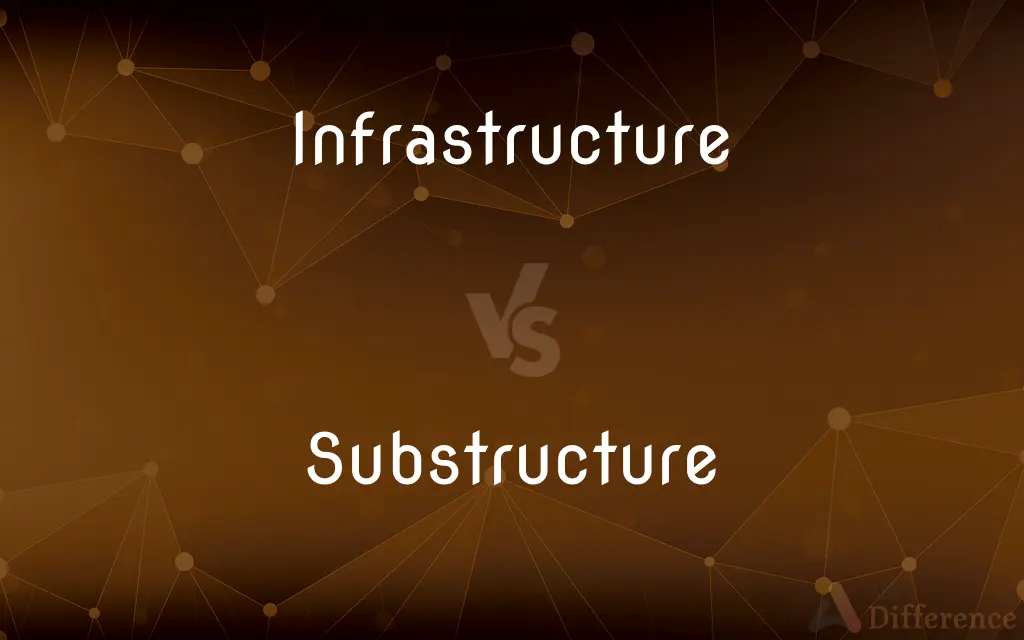Infrastructure vs. Substructure — What's the Difference?
By Tayyaba Rehman & Fiza Rafique — Updated on April 29, 2024
Infrastructure refers to the fundamental facilities and systems serving a country or area, such as transportation and communication systems, whereas substructure is the underlying structure forming the foundation of a building or other construction.

Difference Between Infrastructure and Substructure
Table of Contents
ADVERTISEMENT
Key Differences
Infrastructure includes essential services and facilities like roads, bridges, and utilities that support economic activities, whereas substructure specifically refers to the base upon which structures like buildings and bridges are built.
Infrastructure projects can be large-scale and involve significant investment from public and private sectors, focusing on enhancing a region's overall functionality and efficiency. On the other hand, substructure deals primarily with engineering aspects that ensure the stability and durability of individual constructions.
The design and maintenance of infrastructure often require coordination among various government entities and private companies to address broad public needs, whereas substructure design focuses on technical specifications and materials suitable for supporting the superstructure.
Infrastructure development impacts a broad spectrum of society and the economy, aiming to improve quality of life and economic productivity. Conversely, substructure is critical in ensuring the safety and longevity of construction projects but is generally not visible or directly interacted with by the general public.
While infrastructure is typically intended for public use and benefits a large population, substructure is a technical component that serves as the unseen yet crucial support for buildings and other structures.
ADVERTISEMENT
Comparison Chart
Definition
The basic physical systems of a community or nation
The underlying structure of a construction
Scale of impact
Regional or national
Individual construction projects
Visibility
Highly visible and accessible to the public
Typically hidden and unnoticed by the public
Main Focus
Enhancing economic efficiency and quality of life
Structural stability and support
Typical Examples
Roads, bridges, water supply systems
Foundations, basements
Compare with Definitions
Infrastructure
Major physical networks necessary for economic operation.
Reliable infrastructure is vital for efficient transportation.
Substructure
Primarily concerned with stability and load-bearing.
The substructure must support the entire weight of the building.
Infrastructure
Public and private structural components that ensure health and safety.
Government investment in infrastructure can lead to improved public health.
Substructure
A critical unseen component of construction projects.
Engineers inspected the substructure for potential weaknesses.
Infrastructure
Systems and facilities that support societal functions.
The new airport is considered critical infrastructure for the city.
Substructure
Specific engineering focus within the broader construction field.
The architect and engineer discussed the substructure plans extensively.
Infrastructure
Infrastructure is often subject to political debate due to its impact on development.
Politicians argue about infrastructure funding during the elections.
Substructure
The base or foundation on which structures are built.
The building's substructure was reinforced to withstand earthquakes.
Infrastructure
Infrastructure includes both hard and soft components like roads and services.
Effective communication infrastructure is essential for emergency responses.
Substructure
Substructure design varies based on geographical and environmental factors.
Coastal buildings require a substructure resistant to corrosion.
Infrastructure
Infrastructure is the set of fundamental facilities and systems that support the sustainable functionality of households and firms. Serving a country, city, or other area, including the services and facilities necessary for its economy to function.
Substructure
The supporting part of a structure; the foundation.
Infrastructure
An underlying base or foundation especially for an organization or system.
Substructure
The earth bank or bed supporting railroad tracks.
Infrastructure
The basic facilities, services, and installations needed for the functioning of a community or society, such as transportation and communications systems, water and power lines, and public institutions including schools, post offices, and prisons.
Substructure
The supporting part of a structure (either physical or organizational; the foundation).
Infrastructure
(systems theory) An underlying base or foundation especially for an organization or system.
Common Language Infrastructure
The parasitic tyranny's infrastructure depends on secrecy in order to be effective.
Substructure
The earth or gravel that the railway tracks are embedded in.
Infrastructure
The basic facilities, services and installations needed for the functioning of a community or society.
Substructure
(Marxism) base
Infrastructure
The basic structure or features of a system or organization
Substructure
Same as Substruction.
Infrastructure
The stock of basic facilities and capital equipment needed for the functioning of a country or area;
The industrial base of Japan
Substructure
An under structure; a foundation; groundwork.
Substructure
The basic structure or features of a system or organization
Substructure
Lowest support of a structure;
It was built on a base of solid rock
He stood at the foot of the tower
Common Curiosities
How do infrastructure and substructure differ in visibility?
Infrastructure is generally highly visible and directly utilized by the public, whereas substructure is usually hidden and unnoticed.
Can infrastructure include digital components?
Yes, modern infrastructure often includes digital components such as broadband networks and smart grids.
What is a substructure?
A substructure is the underlying structure or foundation of a building, bridge, or other construction.
What is infrastructure?
Infrastructure refers to the fundamental facilities and systems serving a country or area, including transportation, communication, water, and power systems.
Is substructure only related to buildings?
While commonly associated with buildings, substructure also applies to other constructions like bridges and tunnels.
What is the economic impact of infrastructure?
Robust infrastructure can significantly boost economic efficiency and productivity by improving transportation and communication.
How does substructure affect a construction project?
A well-designed substructure is essential for the safety, stability, and longevity of any construction project.
What role do engineers play in substructure design?
Engineers are crucial in designing substructures to ensure they meet all technical and safety standards.
Who manages infrastructure development?
Infrastructure development is typically managed by governmental bodies and sometimes private sector entities.
What materials are commonly used in substructures?
Common materials include concrete, steel, and wood, chosen based on the environmental and load-bearing requirements.
Can substructure be modified after construction?
Modifications to substructure are possible but can be complex and costly due to its foundational nature.
Share Your Discovery

Previous Comparison
Baal vs. Moloch
Next Comparison
Divo vs. DivaAuthor Spotlight
Written by
Tayyaba RehmanTayyaba Rehman is a distinguished writer, currently serving as a primary contributor to askdifference.com. As a researcher in semantics and etymology, Tayyaba's passion for the complexity of languages and their distinctions has found a perfect home on the platform. Tayyaba delves into the intricacies of language, distinguishing between commonly confused words and phrases, thereby providing clarity for readers worldwide.
Co-written by
Fiza RafiqueFiza Rafique is a skilled content writer at AskDifference.com, where she meticulously refines and enhances written pieces. Drawing from her vast editorial expertise, Fiza ensures clarity, accuracy, and precision in every article. Passionate about language, she continually seeks to elevate the quality of content for readers worldwide.
















































